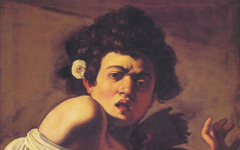Raphael’s Madonna della Sedia (1513-14)
It has already been shown in an entry on the Vatican Pieta that Michelangelo identified with the Virgin Mary and her Immaculate Conception. He audaciously inscribed his name across her chest and gave his feminine alter ego the large hands of a sculptor. The Virgin presents her adult son, inexplicably smaller than her if one thinks literally, as an example of the best “sculpture” she (Michelangelo) had ever produced…
….Separately, I showed how Leonardo also identified with the Virgin in the Madonna of the Rocks. He placed the biblical characters inside a cave-like structure with two eye-holes collapsing in the background as a metaphor for his own skull. In this ancient yet fertile place plants grow untended in the foreground leading Frederick Hartt to conclude that we are looking at “the womb of Mary”.1 He is right: Leonardo’s mind is Mary’s womb in the process of conceiving a god.
It is likely then that Raphael, their contemporary rival who specialized in the Madonna and Child theme, would have identified with the Virgin too. He often signed the mantle circling her neck as a mark of self-identity. Rona Goffen remarked that “Raphael’s labels (around the Virgin’s neck) clearly express his veneration while asserting the intimacy of his relationship with the Virgin Mary.”2 Here, though there is no mantle to sign, the picture itself has become circular, a rare tondo out of which emerges the Virgin and Child sitting on the Throne of Wisdom.3The tondo is Raphael's "eye".
Click next thumbnail to continue

Left: Detail of Raphael's Madonna delle Sedia
Right: Detail of Raphael's Self-portrait (rotated and inverted)
Click image to enlarge.
Besides, the Virgin so clearly resembles Raphael’s earliest self-portrait that the likeness must have been both significant and intentional. No-one seems to have noticed this before because no-one imagined it. 4
Click next thumbnail to continue
Lastly, now that we know that Raphael identified with the Virgin, her turban becomes more significant. Painters often wore turbans in the studio to prevent paint getting on their hair and some even wore them in their self-portraits, Van Eyck and Rembrandt being two prominent examples.
More Works by Raphael
We have seen elsewhere how artists use the arrows of St. Sebastian, the saint's identifying attribute, as symbols for their own paintbrushes.

Raphael’s Galatea (1512)
Notes:
Originally published online: 18th July 2011
1. Frederick Hartt, “Mantegna’s Madonna of the Rocks”, Gazette des Beaux-Arts 40, Dec. 1952, p. 342
2. Rona Goffen, “Raphael’s Designer Labels: From the Virgin Mary to La Fornarina”, Artibus et Historiae 24, No. 48, 2003, p. 132
3. Christiane L. Joost-Gaugier, “Raphael’s Harmonia Mundi: The Cieling of the Stanza della Segnatura and Its Meaning”, Gazette des Beaux-Arts CXXXVI, Oct. 2000, pp.109-24
4. As far as I know, the likeness has never been noted before though, given the size of the literature on Raphael, it is also difficult to confirm.
Original Publication Date on EPPH: 05 Dec 2012. | Updated: 0. © Simon Abrahams. Articles on this site are the copyright of Simon Abrahams. To use copyrighted material in print or other media for purposes beyond 'fair use', you must obtain permission from the copyright owner. Websites may link to this page without permission (please do) but may not reproduce the material on their own site without crediting Simon Abrahams and EPPH.






